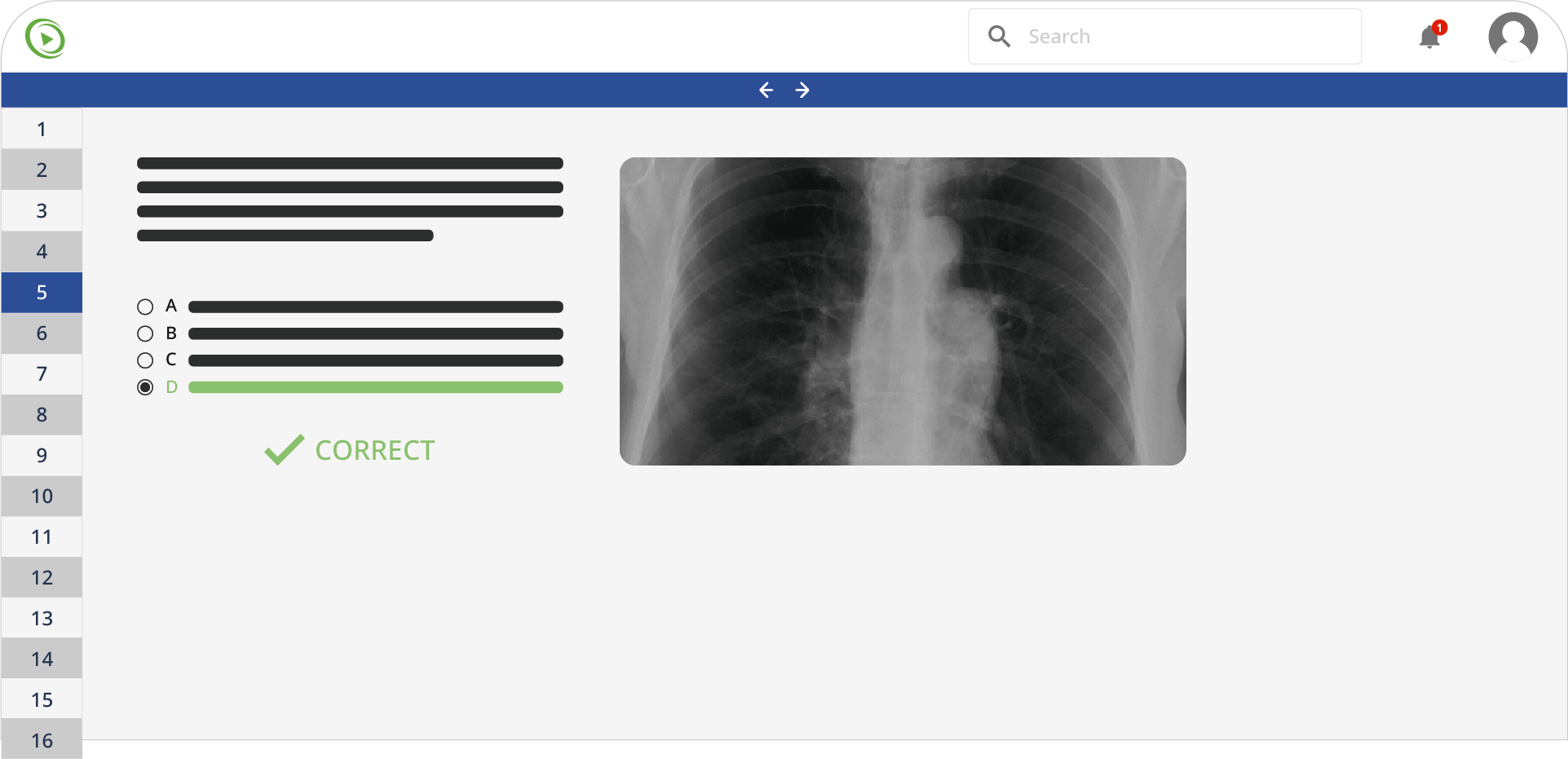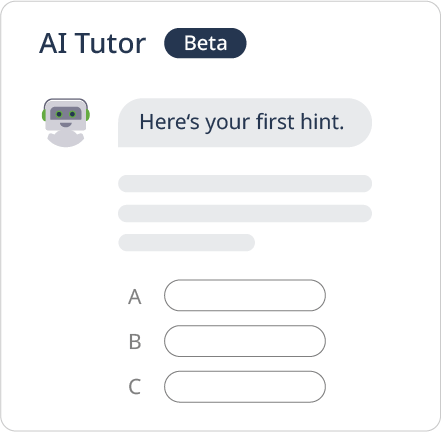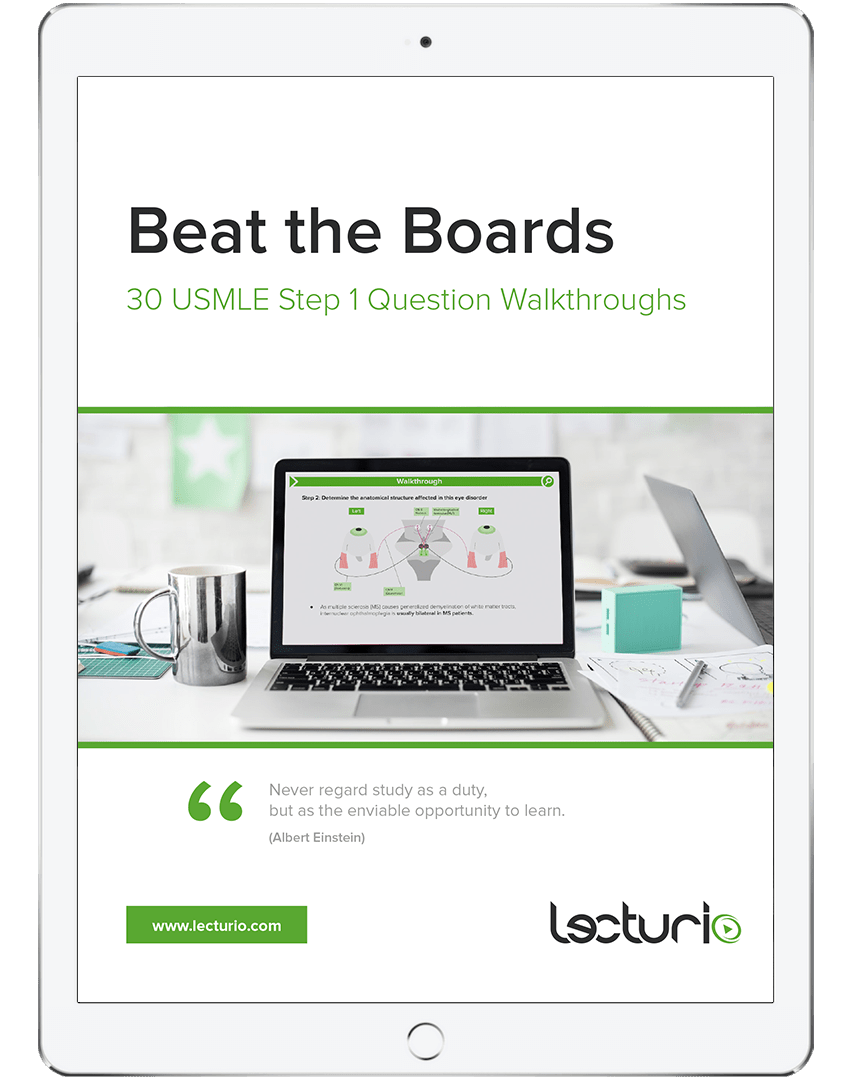Preview 10 Free USMLE® Step 1 Questions
A 25-year-old man is admitted to the hospital after a severe motor vehicle accident as an unrestrained front-seat passenger. Appropriate life-saving measures are given, and the patient is now hemodynamically stable. Physical examination shows a Glasgow Coma Score of 12. There are no motor or ocular movements with painful stimuli. The patient has bilaterally intact pupillary light reflexes. The patient is placed in a 30° semi-recumbent position for further examination. What is the most likely finding on the examination of this patient’s right ear?
A. Cold water causing ipsilateral saccadic movement
B. Warm water causing an ipsilateral slow pursuit
C. Warm water causing ipsilateral saccadic movement
D. Warm water mimicking the head-turning left
E. Cold water causing contralateral slow pursuit
A 50-year-old man presents to the office with complaints of fever and chills for 4 weeks. He adds that he is fatigued all the time and has a generalized weakness. He has drenching night sweats and has had 2 episodes of non-bilious vomiting over the past few days. He traveled to the Netherlands for 4 days a month ago. His symptoms started a few days after he returned home. Laboratory testing revealed the following:
| Hemoglobin | 11.2 g/dL |
| Hematocrit | 29% |
| Leukocyte count | 2,950/mm3 |
| Neutrophils | 59% |
| Bands | 3% |
| Eosinophils | 1% |
| Basophils | 0% |
| Lymphocytes | 31% |
| Monocytes | 4% |
| Platelet count | 60,000/mm3 |
| Unconjugated bilirubin | 12 mg/dL |
| Alanine aminotransferase | 200 IU/L |
| Aspartate aminotransferase | 355 IU/L |
The peripheral blood smear showed basophilic ring- and pear-shaped structures inside many red cells and extracellular basophilic rings on Wright-Giemsa staining. Further evaluation revealed parasitemia and a few schistocytes, poikilocytes, and merozoites in tetrad formation. The findings are most consistent with which diagnosis?
A. Malaria
B. Babesiosis
C. Anaplasmosis
D. Tuberculosis
E. Lyme disease
A 22-year-old professional softball player is undergoing an annual check-up. Her medical history is significant for hallux valgus and scoliosis. She additionally notes that she frequently has bumps and bruises from playing softball, but she has no injuries today. Her family history is significant for heart disease. The patient’s blood pressure is 110/70 mm Hg, heart rate is 78/min, and respiratory rate is 15/min. A physical examination is unremarkable except for an indurated palpable mass on her left breast. A biopsy of the mass is performed. Which biopsy findings are most likely to be present in this patient?
A. Chronic inflammation with plasma cells
B. Necrotic fat with calcifications and giant cells
C. Leaf-like projections
D. Duct-like structures
E. Abundant extracellular mucin
A 55-year-old woman presents to the office because she has been feeling weak. For the past 2 years, she has been urinating a considerable volume every time she goes to the bathroom. She has no past medical history. Her heart rate is 86/min, respiratory rate is 15/min, temperature is 37.4°C (99.3°F), and blood pressure is 111/79 mm Hg. Laboratory studies are significant for the following:
| Calcium | 13.8 mg/dL |
| PTH | 230 pg/mL |
Her complete metabolic panel is otherwise within normal limits. Imaging studies show subperiosteal resorption and osteoporosis. Scintigraphy reveals the most common pathologic condition associated with the patient’s diagnosis. Which of the following is the most likely diagnosis in this patient?
A. Adenoma
B. Carcinoma
C. Decreased calcitriol concentration
D. Glandular hyperplasia
E. Phosphate retention
A 48-year-old man is brought to the emergency department by his neighbor, who found him lying unconscious at the door of his house. The patient lives alone and no further history is available. On physical examination, his temperature is 37.2ºC (98.9ºF), pulse rate is 114/min, blood pressure is 116/78 mm Hg, and respiratory rate is 22/min. His Glasgow Coma Scale score is 7 and the patient is intubated. A stat serum osmolality is reported at 260 mmol/kg. Based on the provided information, which of the following conditions is most likely present in this patient?
A. Acute ethanol intoxication
B. Central diabetes insipidus
C. Diabetic ketoacidosis
D. Nonketotic hyperosmolar hyperglycemic coma
E. Syndrome of inappropriate antidiuretic hormone
A 40-year-old woman with a recent history of carcinoma of the breast status-post mastectomy and neoadjuvant chemotherapy 1 week ago presents for follow-up. She reports adequate pain control with the analgesic drug she was prescribed. Her past medical history is significant for hepatitis C and major depressive disorder. The patient denies any history of smoking or alcohol use but says she is currently using intravenous heroin and has been doing so for the past 10 years. However, she reports that she has been using much less heroin since she started taking the pain medication, which is confirmed by the toxicology screen. Which of the following is the primary mechanism of action of the analgesic drug she was most likely prescribed?
A. Partial agonist at opioid receptors
B. Pure antagonist at opioid receptors
C. Inhibits prostaglandin synthesis
D. Pure agonist at the µ-opioid receptor
E. Central action via blockade of serotonin reuptake
A 60-year-old man seeks evaluation at a medical office due to leg pain while walking. He says the pain starts in his buttocks and extends to the thighs and down to the calves. Previously, the pain resolved with rest, but the pain now persists in his feet, even during rest. The past medical history is significant for diabetes mellitus, hypertension, and cigarette smoking. The vital signs are within normal limits. The physical examination shows an atrophied leg with bilateral loss of hair. Which of the following is the most likely cause of this patient’s condition?
A. Decreased permeability of endothelium
B. Narrowing and calcification of vessels
C. Peripheral emboli formation
D. Thrombus formation
E. Weakening of vessel wall
A 33-year-old woman presents with lethargy and neck pain. She says that, for the past 6 months, she has been feeling tired all the time and has noticed a lot of muscle tension around the base of her neck. She also says she finds herself constantly worrying about everything, such as if her registered mail would reach family and friends in time for the holidays or if the children had their nightly baths while she was away for the weekend. She says that this worrying has prevented her from sleeping at night and has made her more irritable and edgy with her family and friends. Which of the following is the best course of treatment for this patient?
A. Buspirone
B. Diazepam
C. Family therapy
D. Support groups
E. A vacation
A healthy 37-year-old gravida-3-para-1 (G-3-P-1) who underwent in vitro fertilization delivers a boy vaginally. On examination, he is found to have a ventral urethral meatus inferior to the glans. Which statement is correct?
A. Younger age of the mother is a major risk factor for this condition
B. It results from failure of the genital swellings to fuse
C. Hypospadias repair before the age of 3 years is associated with an increased incidence of urethrocutaneous fistula
D. Such anatomy is formed before the 12th week of intrauterine development
E. It results from failure of the urethral folds to fuse
Parkinson’s disease is a progressive neurodegenerative disease. It is characterized by a loss of dopaminergic neurons in the substantia nigra pars compacta and the formation of cellular inclusions called Lewy bodies. These are composed of α-synuclein that has been bound to ubiquitin. In healthy individuals, α-synuclein bound to ubiquitin would be degraded by which of the following?
A. Vesicle
B. Peroxisome
C. Proteasome
D. Ribosome
E. Lysosome
Do you want to answer more USMLE Step 1 practice questions?
Create a free Lecturio account and you will:
- Access the Lecturio question bank, with more than 2,200 USMLE Step 1 practice questions
- Get sent a USMLE question of the day daily to your phone with the mobile app
- Monitor your exam-readiness with USMLE free tests and self-assessments
Preview 10 Free USMLE® Step 2 Questions
A 65-year-old man is brought to the emergency department after losing consciousness. He is accompanied by his wife. He is started on intravenous fluids. His vital signs are blood pressure 85/50 mm Hg, pulse 50/min, and respiratory rate 10/min. He has been admitted in the past for a heart condition. His wife is unable to recall the name of the condition, but she does know that the doctor recommended some medications at that time in case his condition worsened. She has brought with her the test reports from previous medical visits over the last few months. She says that she has noticed that he often has difficulty breathing and requires three pillows to sleep at night to avoid being short of breath. He can only walk for a few minutes before he has to stop and rest. His wife also reports that he has had occasional severe coughing spells with pinkish sputum production. She also mentions that he has been drinking alcohol for the past 30 years. Which of the following medications will improve the prognosis of this patient?
A. Furosemide
B. Enalapril
C. Digoxin
D. Amiodarone
E. Amlodipine
A 2-year-old boy is presented to the pediatrician with poor weight gain and fatigue. His mother states that the patient barely engages in any physical activity because he easily becomes short of breath. His prenatal and birth histories are insignificant. The patient’s past medical history includes a few upper respiratory tract infection episodes that were treated successfully. He is in the 10th percentile for weight and 40th percentile for height. His heart rate is 122/min, blood pressure is 102/56 mmHg, and respiratory rate is 32/min. Cardiac auscultation reveals clear lungs and a grade 2/6 holosystolic murmur that is loudest at the left lower sternal border. The remainder of the physical examination is negative for clubbing, cyanosis, and peripheral edema. Which of the following is the most likely diagnosis in this patient?
A. Patent ductus arteriosus (PDA)
B. Atrial septal defect (ASD)
C. Ventricular septal defect (VSD)
D. Coarctation of the aorta
E. Tetralogy of Fallot (TOF)
A 36-year-old primigravida presents to her obstetrician for antenatal care. She is at 26 weeks of gestation and does not have any current complaints except for occasional leg cramps. She does not smoke or drink alcohol. Family history is irrelevant. Her temperature is 36.9°C (98.42°F), the blood pressure is 100/60 mm Hg, and the pulse is 95/minute. Her body mass index is 21 kg/m² (46 pounds/m²). Physical examination reveals a palpable uterus above the umbilicus with no other abnormalities. Which of the following screening tests is suitable for this patient?
A. HbA1c for gestational diabetes mellitus
B. Oral glucose tolerance test for gestational diabetes mellitus
C. Fasting and random glucose testing for gestational diabetes mellitus
D. Wet mount microscopy of vaginal secretions for bacterial vaginosis
E. Complete blood count for iron deficiency anemia
A 52-year-old man presents to the emergency department because of bilateral leg swelling and puffiness of both eyes in the morning. His symptoms started about 2 weeks ago. He denies smoking or alcohol use and his family history is noncontributory. The vital signs include: temperature 36.8°C (98.2°F), blood pressure 162/87 mm Hg, and pulse 85/min. On physical examination, he is jaundiced and there is hepatosplenomegaly and 2+ lower extremity edema up to the mid-thigh. Laboratory studies show:
| Anti-HCV | Reactive |
| Serum albumin | 3 g/dL |
| Urine dipstick | 3+ protein |
| Urinalysis | 10–15 red blood cells/high-power field (RBCs/HPF) and red cell casts |
Which of the following is a feature of this patient’s condition?
A. Subendothelial immune complex deposits
B. Phospholipase A2 receptor antibodies
C. Normal complement level
D. Renal vasoconstriction and altered autoregulation
E. Few immune complex deposits
A 43-year-old woman was admitted to the hospital after a fall. When the emergency services arrived, she was unresponsive, did not open her eyes, but responded to painful stimuli. The witnesses say that she had convulsions lasting about 30 seconds when she lost consciousness after a traumatic event. On her way to the hospital, she regained consciousness. On admission, she complained of intense headaches and nausea. She opened her eyes spontaneously, was responsive but confused, and was able to follow motor commands. Her blood pressure is 150/90 mm Hg, heart rate is 62/min, respiratory rate is 13/min, and temperature is 37.3℃ (99.1℉). There are no signs of a skull fracture. The pupils are round, equal, and poorly reactive to light. She is unable to fully abduct both eyes. Ophthalmoscopy does not show papillary edema or retinal hemorrhages. She has nuchal rigidity and a positive Kernig sign. An urgent head CT does not show any abnormalities. Which of the following is the next best step for this patient?
A. Brain MRI
B. Lumbar puncture
C. Angiography
D. EEG
E. Sonography
A 15-year-old African American boy presents to the pediatrician with yellow discoloration of his sclerae for the last 3 days. His mother reports that he developed prolonged jaundice during the neonatal period. Vital signs are within normal limits. Physical exam reveals scleral icterus, mild splenomegaly, and pallor. Laboratory studies show the following:
| Hemoglobin | 9.9 g/dL |
| Total leukocyte count | 7,500/mm3 |
| Platelet count | 320,000/mm3 |
| Reticulocyte count | 5% |
| Mean corpuscular hemoglobin | 27.7 pg/cell |
| Mean corpuscular hemoglobin concentration | 32% g/dL |
| Mean corpuscular volume | 84 μm3 |
| Serum total bilirubin | 4.2 mg/dL |
| Serum direct bilirubin | 0.3 mg/dL |
| Coombs test | Negative |
Peripheral smear demonstrates polychromasia, blister cells, and Heinz bodies. Abdominal ultrasonography reveals the presence of gallstones. Which of the following tests is most likely to be abnormal for this patient?
A. Glycerol lysis test
B. Methemoglobin reduction test
C. Serum thyroxine, triiodothyronine, and thyroid-stimulating hormone
D. Serum lipoprotein-X level
E. Hepatoiminodiacetic acid scanning
A 24-year-old woman with a past medical history significant only for endometriosis presents to the outpatient clinic with a 2-cm left breast mass that she first identified 6 months earlier. On review of systems, the patient states that the mass is not painful and, by her estimation, has not significantly increased in size since she first noticed it. On physical examination, there is a palpable, round, rubbery, mobile mass approximately 2 cm in diameter. Given the lesion’s characteristics and the patient’s demographics, what is the most likely diagnosis?
A. Fibrocystic change
B. Fibroadenoma
C. Cystosarcoma phyllodes
D. Ductal carcinoma in situ
E. Invasive breast carcinoma
A 3-day-old boy is brought to the pediatrician for nonpigmented vomiting for the last day. A detailed developmental history reveals that his parents have a nonconsanguineous marriage. He was born by cesarean section at 36 weeks of gestation. His birth weight was 2.6 kg (5.7 lb), and he has been breastfed exclusively. His temperature is 37.0ºC (98.6°F), pulse is 120/min, and respiratory rate is 35/min. On physical examination, a distended abdomen and signs of dehydration are present. On abdominal imaging, a ‘double bubble’ sign and upper intestinal obstruction is present. Abdominal computed tomography shows narrowing of the second part of the duodenum. Barium enema shows normal rotation of the colon. Which of the following is most likely cause of intestinal obstruction in this patient?
A. Meckel diverticulum
B. Annular pancreas
C. Leukocyte adhesion deficiency
D. Crigler-Najjar type 1
E. Intussusception
A 22-year-old woman from a rural area who recently discovered she was pregnant is referred for a cardiology consultation due to cyanosis, dyspnea, and a cardiac murmur revealed at the initial prenatal visit. She is gravida 1, para 0 with an estimated gestational age of 19 weeks. She says that the murmur was found in her childhood, and the doctor at that time placed her under observation only. However, she has been lost to follow-up and has not had proper follow up in years. Currently, she complains of dizziness and occasional dyspnea on exertion which has gradually increased during her pregnancy. Prior to her pregnancy, she did not have any symptoms. The vital signs are as follows: blood pressure 125/60 mm Hg, heart rate 81/min, respiratory rate 13/min, and temperature 36.7°C (98.0°F). Her examination is significant for acrocyanosis and a fixed splitting of S2 and grade 3/6 midsystolic murmur best heard over the left upper sternal border. Which of the following physiological pregnancy changes is causing the change in this patient’s condition?
A. Increase in pulmonary vascular resistance
B. Increase in heart rate
C. Decrease in systemic vascular resistance
D. Increase in cardiac output
E. Increase in blood volume
A 24-year-old woman, G1P0, presents to her OB/GYN for her annual examination with complaints of painful cramps, abdominal pressure, and bloating with her cycle. She reports that she has not menstruated since her missed abortion requiring dilatation and curettage (D&C) seven months ago. She is sexually active with her husband and is not using any form of contraception. Her BMI is 29. At the clinic, her temperature is 98.9°F, pulse is 80/min, and blood pressure is 120/70 mm Hg. The physical examination is unremarkable. Thyroid-stimulating hormone, follicle-stimulating hormone, and prolactin concentrations are all within normal limits. The patient tests negative for qualitative serum beta‐hCG. A progestin challenge test reveals no withdrawal bleeding. What is the most likely diagnosis?
A. Ectopic pregnancy
B. Pelvic inflammatory disease
C. Endometriosis
D. Asherman syndrome
E. Hypothalamic hypoestrogenism
Do you want to practice more USMLE Step 2 questions?
Create a free Lecturio account and you’ll access the Lecturio question bank, with more than 1,200 USMLE Step 2 CK practice questions.











